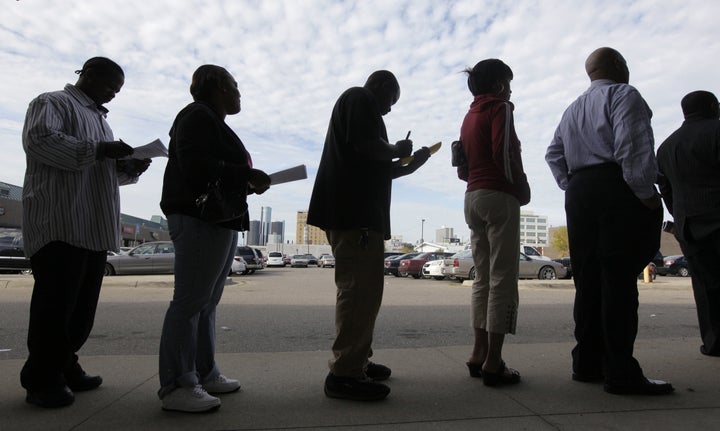
The long lasting economic troubles experienced by the Japanese economy in the 1990s have frequently been referred to by economists as the Lost Decade. In our previous blog, we argued that the past decade (2000-2010) was in many respects a "lost decade" for our nation's economy. The performance of the U.S. economy in producing additional real output (GDP), new payroll employment opportunities, or any employment for workers (16+) over the past decade was the worst in the past 70 years. Total payroll employment in 2010 was below its level in 2000 for the first time since the Great Depression.
These declining labor market opportunities for the vast majority of workers also were accompanied by very weak performance in raising the real weekly earnings of most employed workers, increasing real household income, or reducing poverty problems. There was, however, one area in which the U.S. economy performed well over the past decade. That area was the sharp gain in labor productivity in the nonfarm business sector of the economy. Between 2000 and 2010 (through the 3rd quarter), real output per hour of work in the nonfarm business sector increased by slightly more than 29%, its best record since the decade of the 1960s.
Normally, this sharp gain in labor productivity would have been expected to substantially improve the real weekly earnings of many American workers. Unfortunately, this was not the case. A combination of very slack conditions in labor markets, especially at the beginning and end of the decade, increased international competition, and a declining union bargaining presence kept the increases in hourly and weekly earnings well below the strong gain in labor productivity. The median real weekly earnings of the nation's full-time wage and salary workers rose by only slightly more than 2% over the decade. Among males, the increase in median real weekly earnings was only a little more than 1% while women's weekly earnings rose more strongly by 7% over the decade. The youngest workers (those under 25 years of age) fared the worst, experiencing a three per cent decline in their median weekly earnings while 25-34 year olds' and 45-54 year olds' weekly earnings remained flat, and older workers (55+) gained 11%.
The mean weekly earnings of the nation's nearly 90 million private sector, production and non-supervisory workers increased by only 4% over the decade. In contrast, corporate profits (before tax) increased in real terms (in constant 1999 dollars) by $470 billion or 58%. The growth in the level of these pre-tax corporate profits was about five times higher than the total growth in the annual pre-tax earnings of the nation's nearly 90 million production and non-supervisory workers.
The declines in payroll employment, the steep rise in unemployment and underemployment, and limited wage gains for those in the bottom and middle of the weekly wage distribution helped push down the real annual incomes of nearly all U.S. households. The median real annual income of U.S. households declined over the decade by $2,600 or 5%. This was the first time since the end of World War II that median household income failed to grow over an entire decade.
Real annual incomes of U.S. households fell all along the distribution from top to bottom; however, the relative sizes of these income losses were largest at the bottom and middle of the distribution. The real income of those at the 10th percentile fell by close to 10 per cent, those in the middle of the distribution by 5 per cent, and those at the near top of the distribution (90th and 95th percentiles) by only one per cent. These divergent trends in annual income losses generated an increase in the degree of inequality in the household income distribution of the nation. The share of aggregate household income captured by the top quintile increased over the decade, rising above 50% by 2001 and hitting 50.4% by the end of the decade (in 2009). Every other group's share of the income pie declined over the decade. In 2009, the most affluent one-fifth of households received more income than the bottom 80 per cent of households combined. In his 1937 Inaugural Address to the nation, then President Franklin Roosevelt exclaimed that, "The test of our progress is not whether we add more to the abundance of those who have too much; it is whether we provide enough for those who have too little." The economic results for the past decade clearly indicate that we have failed this test.
The combination of declining real household incomes and a worsening degree of inequality combined to push up the incidence of official poverty problems by the end of the decade. In 2009, the overall poverty rate of the nation had increased to 14.3%, the highest person poverty rate since 1994. All of the increase in poverty problems took place among the nation's non-elderly population under age 65, with the youngest members faring the worst. More than 1 of every 5 children under age 18 were living in poverty, with more than 38% of children in the nation's youngest families (head under 30) being poor in that year. Among the nation's 18-64 year olds, 13% were poor, the highest such poverty rate among this age group since the early years of the 1960s. The War on Poverty was being lost in the Lost Decade. One can only hope that this outcome will not be repeated in the new decade. But as Jose Saramago noted in The Double (2007), "It is a well known fact that no human being can live solely on hope".
Andrew Sum and Joseph McLaughlin, Center for Labor Market Studies, Northeastern University.